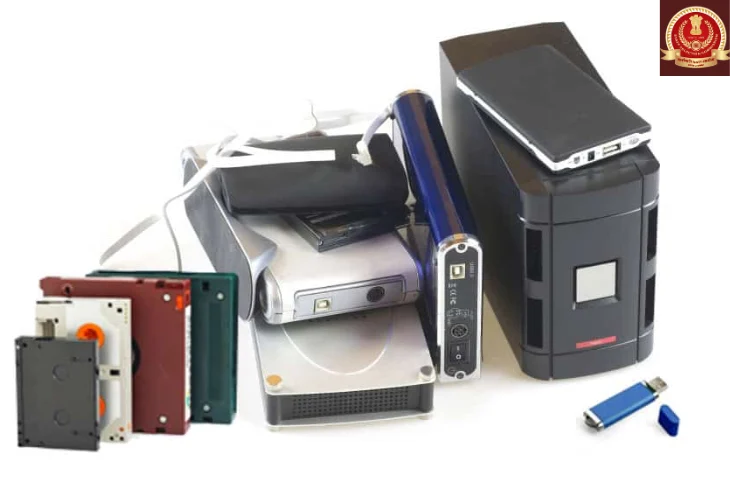Backup devices are an important topic for SSC CGL Tier 2 Computer Awareness. They are essential for storing data safely and preventing data loss due to hardware failure, viruses, or accidental deletion. In this guide, we explain types of backup devices, their features, advantages, and uses in simple language.
What are Backup Devices?
Backup devices are hardware or storage systems used to store copies of important data. These devices ensure that if the original data is lost, a backup can restore it quickly. The key purposes of backup devices:
- Protect data from accidental loss or damage.
- Enable data recovery in case of hardware or software failure.
- Help in long-term data storage.
Types of Backup Devices
Backup devices are mainly divided into Magnetic, Optical, and Flash-based devices.
1. Magnetic Backup Devices
Magnetic devices store data using magnetic fields. They are widely used for large data storage. Magnetic backup devices are cost-effective for storing large volumes of data. SSC CGL Tier 2 questions may ask about capacity, cost, and types of magnetic storage.
| Device | Storage Medium | Capacity | Advantages | Example Use |
| Hard Disk Drive (HDD) | Magnetic disk | 500 GB – 20 TB | Fast access, reusable | System backup, media storage |
| Magnetic Tape | Tape reel | Up to several TB | Very cheap, long-term storage | Large-scale archival, server backup |
2. Optical Backup Devices
Optical devices store data using laser technology on discs like CDs or DVDs. They are durable and portable, suitable for medium-sized backups.
| Device | Storage Medium | Capacity | Advantages | Example Use |
| CD | Optical disc | 700 MB | Portable, easy to read | Small backups, software storage |
| DVD | Optical disc | 4.7 GB – 8.5 GB | Higher capacity than CD | Media storage, documents |
| Blu-ray Disc | Optical disc | 25 – 100 GB | Very high storage | High-definition video backup |
Also check out: SSC CGL Typing Test Errors to minimize your errors in Data Entry Speed Test.
3. Flash-Based Backup Devices
Flash devices use solid-state memory, making them fast and portable. They are are widely used for quick backups and portability.
| Device | Storage Medium | Capacity | Advantages | Example Use |
| USB Flash Drive | Flash memory | 4 GB – 2 TB | Portable, fast | Personal file backup |
| Memory Card | Flash memory | 2 GB – 1 TB | Small, portable | Cameras, smartphones |
| External SSD | Flash memory | 250 GB – 8 TB | Very fast, durable | System backup, large files |
Volatile vs Non-Volatile Backup Devices
Although backup devices store data permanently, volatile and non-volatile memory concepts are relevant when discussing internal vs external backups.
| Feature | Volatile Memory | Non-Volatile Backup Device |
| Data Retention | Lost when power is off | Retained without power |
| Examples | RAM, Cache | HDD, SSD, Tape, CD/DVD |
| Use | Temporary storage during operations | Permanent backup and archival |
Key Takeaways:
Below are the key takeaways:
- Backup devices prevent data loss and ensure recovery.
- Magnetic devices are cheap and store large data; tapes are ideal for long-term storage.
- Optical devices like CD/DVD are portable but have limited capacity.
- Flash-based devices like USB and SSD are fast, portable, and reliable.
- SSC CGL Tier 2 questions may ask about device types, storage capacity, advantages, and examples.
FAQs
Ans. Backup devices are hardware used to store copies of important data to protect against loss, damage, or system failure.
Ans. The main types of backup devices are Magnetic (HDD, Tape), Optical (CD, DVD, Blu-ray), and Flash-based (USB, SSD, Memory Card).
Ans. Flash-based devices like SSDs and USB drives are the fastest due to their solid-state storage technology.
Ans. Magnetic tapes are best suited for long-term archival and server backups as they are cheap and durable.
Ans. Backup devices are a key topic in SSC CGL Tier 2 as questions are asked about device types, storage capacity, speed, and examples.
- Indian Overseas Bank LBO LPT Dates 2025 Out, Check Notice
- PNB LBO Syllabus and Exam Pattern 2025, Check Details
- PNB LBO Salary 2025, In Hand Salary, Perks, and Allowances
- Most Repeated Quantitative Aptitude Questions for SSC CHSL Tier 2
- UPSC EPFO Admit Card 2025 Out, APFC & EO/AO Hall Ticket Link
- CAIIB ABM Formula Sheets for 30 Nov Exam, Download FREE PDFs

I’m Mahima Khurana, a writer with a strong passion for creating meaningful, learner-focused content especially in the field of competitive exam preparation. From authoring books and developing thousands of practice questions to crafting articles and study material, I specialize in transforming complex exam-related topics into clear, engaging, and accessible content. I have first hand experience of 5+ months in SSC Exams. Writing, for me, is not just a skill but a way to support and guide aspirants through their preparation journey one well-written explanation at a time.
